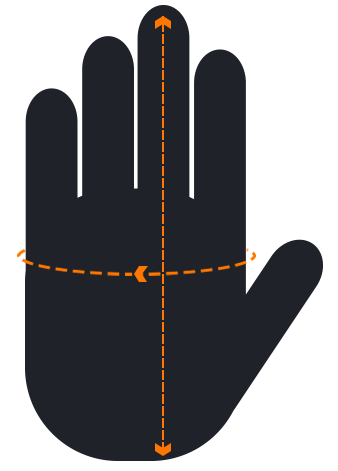Towa OR656 Kev 30cm PVC-Coated Oil-Resistant Gloves
If you work with oil and other chemicals, it's important your gloves provide the adequate and unique protection needed to keep your hands safe and clean, whilst still allowing you to perform the dexterous and precise movements needed to get the job done. With a PVC-coating, an extended cuff and EN 374 certified chemical resistance, Towa OR656 Kev 30cm PVC-Coated Oil-Resistant Gloves are an inexpensive way to protect your hands if you work with potentially hazardous substances and chemicals.
What's Included?
1 x Pair of Oil-Resistant Gloves
Which Size Is Right for Me?
When working in and around machinery, it's important your gloves allow you to perform dexterous and precise movements and tasks whilst still providing you with a high level of protection. Thankfully, finding the right size for you couldn't be easier. Simply measure the circumference and length of your hand (ignoring the thumb area) as demonstrated in the picture below. When you have your measurement, please consult the table beneath to find your size. If your measurement falls on a sizing boundary, we recommend you select a size up for optimum comfort.

| Size | Circumference of Palm (mm) | Length of Palm (mm) |
| Medium | 203mm | 182mm |
| Large | 229mm | 192mm |
| Extra Large | 254mm | 204mm |
Click here for more information and to view our glove sizing guide
Level of Protection
For gloves to be sold as safety wear in Europe, they must pass a stringent set of standardised tests. Please view the information below for a brief description of these regulations and to see how Towa OR656 Gloves performed when tested:
EN 388
EN 388 is a European regulation governing the sale of gloves used for safety and protection. It determines the gloves performance when used whilst working in and around mechanical machinery. Please see the table below for a look at the level of protection Towa OR656 gloves offer:
| Standard | Resistance Level |
| Abrasion Resistance | Level 4 |
| Blade Cut Resistance | Level 1 |
| Tear Resistance | Level 2 |
| Puncture Resistance | Level 1 |
For more information on EN 388, please click here to view our in depth guide
EN 374
EN 374 is a standard regulation used to test how chemical resistant a pair of gloves are. To see how Towa OR656 Gloves performed when tested, please view the table below:
| Chemical Risk Standard | Resistance Level |
| Methanol | Level 2 |
| n-Heptane | Level 2 |
| Sodium Hydroxide 40% | Level 6 |
Key Features and Benefits
- PVC coating provides low adhesion, meaning oil, grease and other substances rarely stick to the glove
- Extended cuff provides excellent protection to the wrist and forearm area
- Gloves are 30cm (12") in length, providing an excellent range of protection
- Inexpensive way to protect hands against grease, oil and other potentially harmful chemicals
- Resistant to a range of chemicals and substances
- Made with a thirteen-gauge seamless cotton liner
- Ergonomic design reduces hand fatigue allowing you to work pain free
- PVC coating stays flexible in low temperatures
- Available in three different sizes
What Are the Benefits of a PVC Coating?
Polyvinyl chloride (PVC) is a coating compound used to strength and bolster materials and fabrics. PVC is a flexible compound that stays incredibly pliable in low temperatures, making it an excellent choice for those working in colder temperatures. Due to its low adherence level, PVC is incredibly resistant to sticky substances, making it ideal for professionals working with and around glue, grease and oil.
Declaration of Conformity







